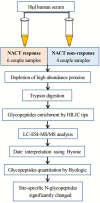Intact glycopeptides identified by LC-MS/MS as biomarkers for response to chemotherapy of locally advanced cervical cancer
- PMID: 37519786
- PMCID: PMC10373866
- DOI: 10.3389/fonc.2023.1149599
Intact glycopeptides identified by LC-MS/MS as biomarkers for response to chemotherapy of locally advanced cervical cancer
Abstract
Objective: For locally advanced cervical cancer (LACC), patients who respond to chemotherapy have a potential survival advantage compared to nonresponsive patients. Thus, it is necessary to explore specific biological markers for the efficacy of chemotherapy, which is beneficial to personalized treatment.
Methods: In the present study, we performed a comprehensive screening of site-specific N-glycopeptides in serum glycoproteins to identify glycopeptide markers for predicting the efficacy of chemotherapy, which is beneficial to personalized treatment. In total, 20 serum samples before and after neoadjuvant chemotherapy (NACT) from 10 LACC patients (NACT response, n=6) and NACT nonresponse, n=4) cases) were analyzed using LC-MS/MS, and 20 sets of mass spectrometry (MS) data were collected using liquid chromatography coupled with high-energy collisional dissociation tandem MS (LC-HCD-MS/MS) for quantitative analysis on the novel software platform, Byos. We also identified differential glycopeptides before and after chemotherapy in chemo-sensitive and chemo-resistant patients.
Results: In the present study, a total of 148 glycoproteins, 496 glycosylation sites and 2279 complete glycopeptides were identified in serum samples of LACC patients. Before and after chemotherapy, there were 13 differentially expressed glycoproteins, 654 differentially expressed glycopeptides and 93 differentially expressed glycosites in the NACT responsive group, whereas there were 18 differentially expressed glycoproteins, 569 differentially expressed glycopeptides and 99 differentially expressed glycosites in the NACT nonresponsive group. After quantitative analysis, 6 of 570 glycopeptides were identified as biomarkers for predicting the sensitivity of neoadjuvant chemotherapy in LACC. The corresponding glycopeptides included MASP1, LUM, ATRN, CO8A, CO8B and CO6. The relative abundances of the six glycopeptides, including MASP1, LUM, ATRN, CO8A, CO8B and CO6, were significantly higher in the NACT-responsive group and were significantly decreased after chemotherapy. High levels of these six glycopeptides may indicate that chemotherapy is effective. Thus, these glycopeptides are expected to serve as biomarkers for predicting the efficacy of neoadjuvant chemotherapy in locally advanced cervical cancer.
Conclusion: The present study revealed that the N-glycopeptide of MASP1, LUM, ATRN, CO8A, CO8B and CO6 may be potential biomarkers for predicting the efficacy of chemotherapy for cervical cancer.
Keywords: LC-MS/MS; biomarker; glycopeptides; locally advanced cervical cancer (LACC); neoadjuvant chemotherapy (NACT).
Copyright © 2023 Li, Feng, Zhu, Jiang, Liu, Feng and Lu.
Conflict of interest statement
The authors declare that the research was conducted in the absence of any commercial or financial relationships that could be construed as a potential conflict of interest.
Figures






Similar articles
-
Glycopeptide Biomarkers in Serum Haptoglobin for Hepatocellular Carcinoma Detection in Patients with Nonalcoholic Steatohepatitis.J Proteome Res. 2020 Aug 7;19(8):3452-3466. doi: 10.1021/acs.jproteome.0c00270. Epub 2020 May 29. J Proteome Res. 2020. PMID: 32412768 Free PMC article.
-
Decreasing expression of HIF-1α, VEGF-A, and Ki67 with efficacy of neoadjuvant therapy in locally advanced cervical cancer.Medicine (Baltimore). 2023 May 19;102(20):e33820. doi: 10.1097/MD.0000000000033820. Medicine (Baltimore). 2023. PMID: 37335690 Free PMC article.
-
SiaQuant Unveils Serum α2,3/α2,6 Sialylation Heterogeneities and Predicts Neoadjuvant Chemotherapy Response in Locally Advanced Cervical Cancer.Anal Chem. 2025 Apr 15;97(14):7682-7691. doi: 10.1021/acs.analchem.4c04952. Epub 2025 Apr 1. Anal Chem. 2025. PMID: 40168059
-
[Recent advances in glycopeptide enrichment and mass spectrometry data interpretation approaches for glycoproteomics analyses].Se Pu. 2021 Oct;39(10):1045-1054. doi: 10.3724/SP.J.1123.2021.06011. Se Pu. 2021. PMID: 34505426 Free PMC article. Review. Chinese.
-
Liquid chromatography-tandem mass spectrometry-based fragmentation analysis of glycopeptides.Glycoconj J. 2016 Jun;33(3):261-72. doi: 10.1007/s10719-016-9649-3. Epub 2016 Jan 18. Glycoconj J. 2016. PMID: 26780731 Review.
Cited by
-
Optimization of glycopeptide enrichment techniques for the identification of clinical biomarkers.Expert Rev Proteomics. 2024 Nov;21(11):431-462. doi: 10.1080/14789450.2024.2418491. Epub 2024 Oct 31. Expert Rev Proteomics. 2024. PMID: 39439029 Review.
-
Unveiling diagnostic and therapeutic strategies for cervical cancer: biomarker discovery through proteomics approaches and exploring the role of cervical cancer stem cells.Front Oncol. 2024 Jan 24;13:1277772. doi: 10.3389/fonc.2023.1277772. eCollection 2023. Front Oncol. 2024. PMID: 38328436 Free PMC article. Review.
-
Characterization of Cell Surface Glycoproteins Using Enzymatic Treatment and Mass Spectrometry.Anal Chem. 2024 Dec 3;96(48):19074-19083. doi: 10.1021/acs.analchem.4c04286. Epub 2024 Nov 18. Anal Chem. 2024. PMID: 39556700 Free PMC article.
-
Identification of 10 differentially expressed genes involved in the tumorigenesis of cervical cancer via next-generation sequencing.PeerJ. 2024 Oct 2;12:e18157. doi: 10.7717/peerj.18157. eCollection 2024. PeerJ. 2024. PMID: 39372720 Free PMC article.
References
-
- Bruni L, Serrano B, Roura E, Alemany L, Cowan M, Herrero R, et al. . Cervical cancer screening programmes and age-specific coverage estimates for 202 countries and territories worldwide: a review and synthetic analysis. Lancet Global Health (2022) 10(8):e1115–27. doi: 10.1016/S2214-109X(22)00241-8 - DOI - PMC - PubMed
-
- . Available at: https://seer.cancer.gov/statfacts/ (Accessed February 15th 2023).
LinkOut - more resources
Full Text Sources
Miscellaneous

